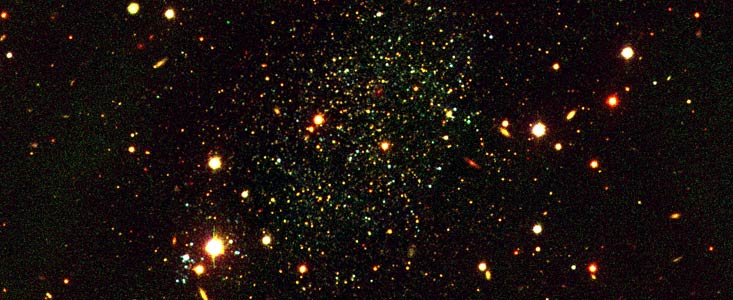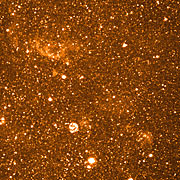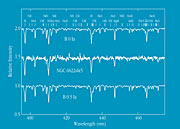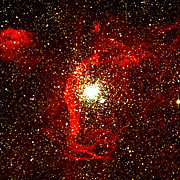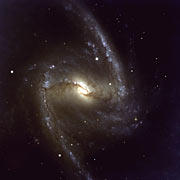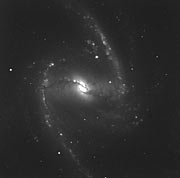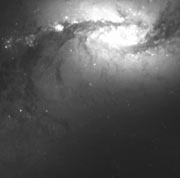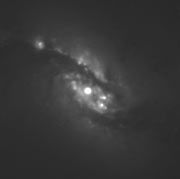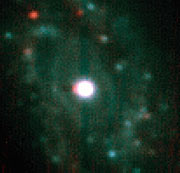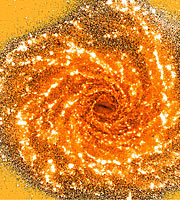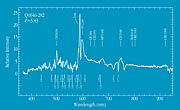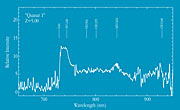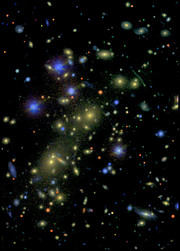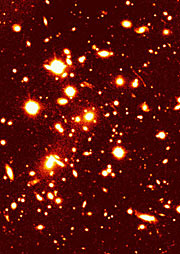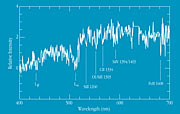Press Release
The VLT Opening Symposium
Scientists Meet in Antofagasta to Discuss Front-Line Astrophysics
27 February 1999
To mark the beginning of the VLT era, the European Southern Observatory is organizing a VLT Opening Symposium which will take place in Antofagasta (Chile) on 1-4 March 1999, just before the start of regular observations with the ESO Very Large Telescope on 1 April, 1999. The Symposium occupies four full days and is held on the campus of the Universidad Catolica del Norte. It consists of plenary sessions on "Science in the VLT Era and Beyond" and three parallel Workshops on "Clusters of Galaxies at High Redshift" , "Star-way to the Universe" and "From Extrasolar Planets to Brown Dwarfs".
There will be many presentations of recent work at the major astronomical facilities in the world. The meeting provides a very useful forum to discuss the latest developments and, in this sense, contributes to the planning of future research with the VLT and other large telescopes.
The symposium will be opened with a talk by the ESO Director General, Prof. Riccardo Giacconi , on "Paranal - an observatory for the 21st century". It will be followed by reports about the first scientific results from the main astronomical instruments on VLT UT1, FORS1 and ISAAC.
The Symposium participants will see the VLT in operation during special visits to the Paranal Observatory. Press conferences are being arranged each afternoon to inform about the highlights of the conference.
After the Symposium, there will be an Official Inauguration Ceremony at Paranal on 5 March
Contributions from ESO
ESO scientists will make several presentations at the Symposium. They include general reviews of various research fields as well as important new data and results from the VLT that show the great potential of this new astronomical facility.
Some of the recent work is described in this Press Release, together with images and spectra of a large variety of objects. Note that all of these data will soon become publicly available via the VLT Archive.
The text below summarizes the individual projects. Comprehensive texts with all photos and diagrammes are available in nine separate web documents that may be accessed via the links at the top of each section. The degree of detail and level of complexity of the texts depend on the subject and the available materials.
1. Dwarf Galaxies in the Local Group
The Antlia Galaxy (FORS1 colour composite) .
In addition to large spiral galaxies like the Milky Way Galaxy, the Andromeda Galaxy and Messier 33, the Local Group of Galaxies contains many dwarf galaxies. The VLT has observed two of these, Antlia and NGC 6822 .
Antlia is a low-surface brightness, spheroidal dwarf galaxy that was only discovered in 1997. While it contains a large amount of atomic hydrogen at its centre, no young stars are found, and it appears that most of its stars are old. This is unlike other dwarf galaxies in the Milky Way neighbourhood, as star formation is expected to occur within dense hydrogen clouds. Further observations will be necessary to understand this unusual characteristics.
The VLT also obtained images of an irregular dwarf galaxy in the Local Group, NGC 6822, as well as spectra of some of its stars. This galaxy is of the "irregular" type and is situated at a distance of about 2 million light-years.
A comparison of the spectra of supergiant stars in NGC 6822 shows that many spectral lines are much weaker than in stars of similar type in the Milky Way, but of similar strength as in stars in the Small Magellanic Cloud. This confirms an earlier finding that NGC 6822 has chemical composition (a lower "metallicity") that is different from what is observed in our Galaxy.
2. The Double Stellar Cluster NGC 1850 in the LMC
NGC 1850 (FORS1 colour composite) .
NGC 1850 is a double cluster in the Large Magellanic Cloud, a satellite galaxy to the Milky Way Galaxy. This cluster is representative of a class of objects, young, globular-like stellar associations , that has no counterpart in our own Galaxy.
The VLT images show faint nebulosity in this area, with filaments and various sharp "shocks". This offers support to the theory of supernova-induced star birth in the younger of the two clusters. It is estimated that about 1000 stars in the older of the clusters have exploded during the past 20 million years.
3. The Barred Galaxy NGC 1365
The Barred Galaxy NGC 1365 (FORS1 colour composite).
NGC 1365 is one of the most prominent "barred" galaxies in the sky. It is a supergiant galaxy and is a member of the Fornax Cluster of Galaxies, at a distance of about 60 million light-years.
This galaxy has an intricate structure with a massive straight bar and two pronounced spiral arms. There are many dust lanes and emission nebulae in these and also a bright nuclear region at the center that may hide a black hole.
Several images of NGC 1365 have recently been obtained with all three astronomical instruments, now installed at the VLT UT1. They show the overall structure of this magnificent galaxy, and also the fine details of the innermost region, close to the centre. An infrared ISAAC image penetrates deep into the obscuring dust clouds in this area.
4. The colours of NGC 1232
Differential (UV-B) image of NGC 1232 (FORS1).
NGC 1232 is a large spiral galaxy in the constellation Eridanus (The River). With a diameter of nearly 200,000 light-years, it is about twice the size of the Milky Way galaxy. The distance is about 100 million light-years, but the excellent optical quality of the VLT and FORS allows us to see an incredible wealth of details.
Computer processed "colour-index images" have been prepared that show the "difference" between images of the galaxy, as seen in different wavebands. Since different types of objects have different brightness in different colours, this method is very useful to locate objects of a particular type and to obtain an overview of their distribution in the galaxy.
The distribution of star-forming regions and dust lanes in NGC 1232 are shown on two such photos.
5. A Selection of ISAAC Spectra
He I 1038 nm line in SN1987A (ISAAC spectrum).
Various observations were made with the ISAAC multi-mode instrument at the Nasmyth focus of VLT UT1 during the recent commissioning periods for this infrared multi-mode instrument. They impressively demonstrate the unique capabilities of this facility.
The new data include several infrared spectra of faint objects with interesting features.
A spectrum was obtained in the near-infrared region of the ring nebula around SN 1987A in the Large Magellanic Cloud. It consists of material blown off the progenitor star during its evolution. Of particular interest is a jet like structure in the dispersion direction which reveals the presence of a broad, blueshifted, HeI component which presumably originates in the shock ionized ejecta.
Another spectrum shows emission features in two galaxies at redshift z = 0.6 [1] that allow the determination of a rotation curve at this large distance. The 1 - 2.5 µm infrared spectrum of the radio galaxy MRC0406 at z =2.42 is also included.
6. The Cluster of Galaxies MS1008.1-1224
Centre of the Cluster of Galaxies MS1008.1-122 (FORS1 colour composite) .
The study of "Deep Fields" is becoming a common tool in astronomy. Among the various sky fields that have been selected for detailed investigation of the faint and distant objects therein, is the FORS Deep Field that will be observed during FORS1 "guaranteed time", available to astronomers from institutes that built this instrument.
In preparation of this work, an imaging programme was carried out during the FORS1 Science Verification programme. Multicolour (UBVRI) deep images were obtained of the galaxy cluster MS1008.1-1224 , to be complemented with infrared (JHK) images with ISAAC of the cluster core. The redshift is z = 0.306 and many arclets from gravitational lensing are seen within the cluster area.
Such observations serve many purposes, including the study of the distribution of mass and the associated gravitational field of the cluster, of individual cluster galaxies, and also of background objects whose images are amplified and distorted by gravitational lensing caused by the cluster.
7. Quasar Spectra
Spectrum of Quasar at z = 5
The FORS1 multi-mode instrument is able to record images as well as spectra of even very distant objects. During the past months, data have been obtained that show the properties of some of the remotest known objects in the Universe.
Three spectral tracings of very distant quasars are included, for which the redshifts have been determined as z = 3.11, 3.83 and 5.0. They were taken by the FORS Commissioning Team in September and December 1998 in the long-slit spectroscopy mode of FORS1. This instrument is very efficient; even for the most distant and faintest quasar, the exposure time was only 1 hour. All spectra show a wealth of details.
8. Spectrum of a Gravitationally Lensed Galaxy
Spectrum of Gravitationally Lensed Galaxy at z = 3.23 (FORS1) .
The galaxy cluster 1ES 0657-55 is located in the southern constellation Carina (The Keel), at redshift z = 0.29. It emits strong and very hot X-ray emission and has an asymmetric galaxy distribution, indicating a large mass and recent formation.
Earlier images with the ESO NTT at La Silla have revealed the presence of a gravitational arc, i.e. a background galaxy at larger distance, whose image is strongly distorted by the gravitational field of this cluster.
New images of this cluster have been obtained with FORS1 under good seeing conditions. They show that this arc is very thin and long. Other arcs and arclets are also visible.
It was possible to obtain a spectrum of the arc. Several absorption lines are well visible and show that the arc is the highly distorted image of a young, background galaxy at redshift z = 3.23.
9. Spectra of Faint Primordial Objects
Spectrum of Distant Galaxy EIS 107 at z = 3.92 (FORS1) .
During the recent commissioning and science verification of FORS1, spectra were taken of several objects, thought to be high-redshift galaxies. These objects are extremely faint and their spectra can only be observed with very large telescopes like the VLT and a highly efficient spectrograph.
The near-infrared (I) magnitudes of the objects studied during the present test observations ranged between 23.4 and 25.5, or between 10 and 65 million times fainter than what can be seen with the unaided eye.
As predicted, a large fraction of the spectra obtained turned out to be those of extremely distant galaxies, in the redshift range between z = 2.8 - 4.0.
Outlook
These observations provide but a small demonstration of the great capability of the ESO VLT to provide front-line astronomical data. Many others will be discussed during the Symposium and contribute to the future planning of the best possible exploitation of this great new research facility.
The first 8.2-m VLT Unit Telescope (UT1) with which the observations reported in this Press Release were made will soon be joined by UT2, for which "First Light" is expected shortly. The first instrument to be mounted on this telescope will be UVES that will provide the capability of obtaining high-dispersion spectra; the next is FORS2. During the coming years, more instruments of different types and capabilities will become available on the four 8.2-m telescopes, together providing an unrivalled potential for astronomical investigations.
Notes
[1]: In astronomy, the redshift (z) denotes the fraction by which the lines in the spectrum of an object are shifted towards longer wavelengths. The observed redshift of a distant galaxy or quasar gives a direct estimate of the universal expansion (i.e. the `recession velocity'). Since this expansion rate increases with the distance, the velocity (and thus the redshift) is itself a function (the Hubble relation) of the distance to the object. The larger the distance, the longer it has taken the light from the object to reach us, and the larger is the "look-back" time, i.e. the fraction of the age of the Universe that has elapsed since the light we now receive, was emitted from the object.
About the Release
| Release No.: | eso9920 |
| Legacy ID: | PR 05/99 |
| Name: | 1ES 0657-558, Meeting, Milky Way, NGC 1232, NGC 1365, NGC 1850, NGC 6822, QSO 0046-282, QSO 0103-294, Small Magellanic Cloud, SMC, Spectrum, Stars |
| Type: | Milky Way : Galaxy Local Universe : Star : Evolutionary Stage : Blue Supergiant Local Universe : Star : Grouping : Cluster Local Universe : Galaxy Local Universe : Galaxy : Type : Spiral Local Universe : Galaxy : Type : Barred Local Universe : Galaxy : Type : Irregular Local Universe : Galaxy : Size : Dwarf Local Universe : Galaxy : Activity : AGN : Seyfert Early Universe : Galaxy Early Universe : Galaxy : Activity : AGN : Quasar Early Universe : Galaxy : Grouping : Cluster |
| Facility: | Very Large Telescope |
| Instruments: | FORS1, ISAAC |
